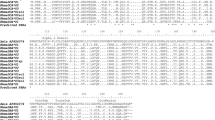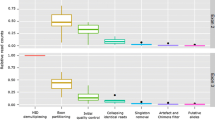Abstract
Immunity to livestock diseases can be studied directly in the target animal, but its elucidation is often constrained by the lack of major histocompatibility complex (MHC)-defined animals. To address this issue, we have established an MHC-defined sheep resource flock generated around four diverse MHC haplotypes. Initial characterisation of the repertoire of transcribed MHC class I genes identified three class I transcripts associated with each haplotype. Nucleotide sequence, transcript abundance and phylogenetic analysis indicated that they represent alleles at up to four polymorphic loci that vary in number between the different haplotypes. The functional significance of each of these genes is evaluated here using complementary molecular genetic and proteomic approaches. We determine which genes give rise to proteins that localise to the surface of transfected cells. In addition, we provide data to support the generation of expressed products, based on immunoprecipitation of class I products from animals homozygous for each of the four MHC haplotypes followed by matrix-assisted laser desorption/ionization time-of-flight mass spectrometry. This provides a clearer picture of the number of MHC class I loci in sheep and allows more rational prediction of their classical (class Ia) or non-classical (class Ib) nature. On the basis of the cellular localisation, phylogenetic and transcriptional analyses, we propose that the ovine MHC comprises a minimum of eight class I loci, with considerable variation between haplotypes.


Similar content being viewed by others
References
Ballingall KT, Dutia BM, Hopkins J, Wright H (1995) Analysis of the fine specificities of sheep major histocompatibility complex class II-specific monoclonal antibodies using mouse L-cell transfectants. Anim Genet 26:79–84
Bijlmkers M, Ploegh H (1993) Putting together an MHC class I molecule. Curr Opin Immunol 5:21–26
Braud VM, Jones EY, McMichael AJ (1997) The human major histocompatibility complex class Ib molecule HLA-E binds signal sequence derived peptides with primary anchor residues at positions 2 and 9. Eur J Immunol 27:1164–1169
Braud VM, Allan DS, McMichael AJ (1999) Functions of nonclassical MHC and non-MHC-encoded class I molecules. Curr Opin Immunol 11:100–108
Brochier B, Kieny MP, Costy F, Coppens P, Bauduin B, Lecocq JP, Languet B, Chappuis G, Desmettre P, Afiademanyo K, Libois R, Pastoret P-P (1991) Large-scale eradication of rabies using recombinant vaccinia-rabies vaccine. Nature 354:520–522
Brown CG, Stagg DA, Purnell RE, Kanhai GK, Payne RC (1973) Infection and transformation of bovine lymphoid cells in vitro by infective particles of Theileria parva. Nature 245:101–103
Chiu NM, Chun T, Fay M, Mandal M, Wang CR (1999) The majority of H2-M3 is retained intracellularly in a peptide-receptive state and traffics to the cell surface in the presence of N-formylated peptides. J Exp Med 190:423–434
Cohen AM, Rumpel K, Coombs GH, Wastling JM (2002) Characterisation of global protein expression by two-dimensional electrophoresis and mass spectrometry: proteomics of Toxoplasma gondii. Int J Parasitol 32:39–51
Ellis S (2004) The cattle major histocompatibility complex: is it unique? Vet Immunol Immunopathol 102:1–8
Ellis SA, Bontrop RE, Antczak DF, Ballingall K, Davies CJ, Kaufman J, Kennedy LJ, Robinson J, Smith DM, Stear MJ, Stet RJM, Waller MJ, Walter L, Marsh SGE (2006) ISAG/IUIS-VIC Comparative MHC Nomenclature Committee report, 2005. Immunogenetics 57:953–958
Grossberger D, Hein W, Marcuz A (1990) Class I major histocompatibility complex cDNA clones from sheep thymus: alternative splicing could make a long cytoplasmic tail. Immunogenetics 32:77–87
Holmes EC, Roberts AF, Staines KA, Ellis SA (2003) Evolution of major histocompatibility complex class I genes in Cetartiodactyls. Immunogenetics 55:193–202
MacHugh ND, Mburu JK, Hamilton MJ, Davis WC (1998) Characterisation of a monoclonal antibody recognising the CD3epsilon chain of the cattle T cell receptor complex. Vet Immunol Immunopathol 61:25–35
Miltiadou D, Ballingall KT, Ellis SA, Russell GC, McKeever DJ (2005) Haplotype characterization of transcribed ovine major histocompatibility complex (MHC) class I genes. Immunogenetics 57:499–509
Potter AA, Babiuk LA (2001) New approaches for antigen discovery, production and delivery: vaccines for veterinary and human use. Curr Drug Targets Infect Disord 1:249–262
Sambrook J, Fritsch EF, Maniatis T (1989) Molecular cloning: a laboratory manual, 2nd edn. Cold Spring Harbor Laboratory, Cold Spring Harbor, NY
Shawar SM, Vyas JM, Rodgers JR, Rich RR (1994) Antigen presentation by major histocompatibility complex class Ib molecules. Ann Rev Immunol 12:839–880
Stevens CE, Taylor PE, Tong MJ, Toy PT, Vyas GN, Nair PV, Weissman JY, Krugman S (1987) Yeast-recombinant hepatitis B vaccine. Efficacy with hepatitis B immune globulin in prevention of perinatal hepatitis B virus transmission. JAMA 257:2612–2616
Toye PG, MacHugh ND, Bensaid AM, Alberti S, Teale AJ, Morrison WI (1990) Transfection into mouse L cells of genes encoding two serologically and functionally distinct bovine class I MHC molecules from a MHC-homozygous animal: evidence for a second class I locus in cattle. Immunology 70:20–26
Treanor JJ, Schiff GM, Hayden FG, Brady RC, Hay CM, Meyer AL, Holden-Wiltse J, Liang H, Gilbert A, Cox M (2007) Safety and immunogenicity of a baculovirus-expressed hemagglutinin influenza vaccine: a randomized controlled trial. JAMA 297:1577–1582
Zinkernagel RM, Callahan GN, Klein J, Dennert G (1978) Cytotoxic T cells learn specificity for self H-2 during differentiation in the thymus. Nature 271:251–253
Acknowledgements
The support of the Bioinformatics and Proteomics Facility at the Moredun Institute is gratefully acknowledged along with the expert assistance provided by the Bioservices Division.
Author information
Authors and Affiliations
Corresponding author
Rights and permissions
About this article
Cite this article
Ballingall, K.T., Miltiadou, D., Chai, ZW. et al. Genetic and proteomic analysis of the MHC class I repertoire from four ovine haplotypes. Immunogenetics 60, 177–184 (2008). https://doi.org/10.1007/s00251-008-0276-4
Received:
Accepted:
Published:
Issue Date:
DOI: https://doi.org/10.1007/s00251-008-0276-4




